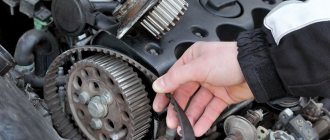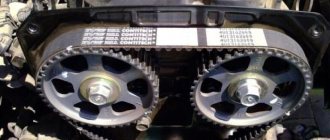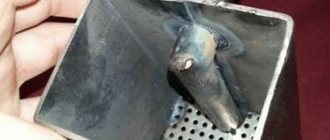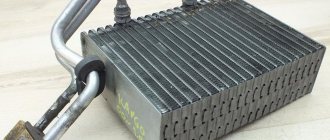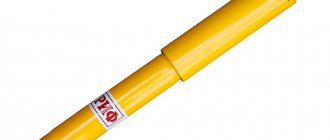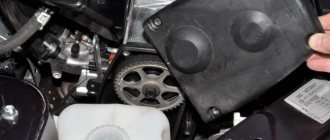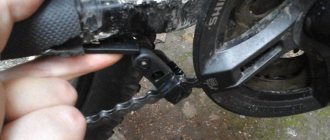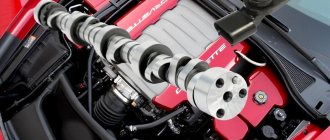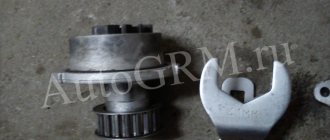Timing mechanism stands for “gas distribution mechanism”. Which is designed to provide the engine with a combustible mixture and release combustion products into the atmosphere. It coordinates the valves, which alternately open and close in the order necessary for the correct operation of the engine.
The timing belt in a car acts as a connecting element between the camshaft and the crankshaft. It is thanks to the timing belt that the camshaft allows the valves to temporarily open and close.
Purpose of the timing belt
The toothed belt transmits torque from the crankshaft to the camshaft. Correct installation of the drive belt will solve the main problem of the gas distribution mechanism. Open the corresponding valve at the right time and close it at the right time. The further algorithm of engine actions will be as follows: intake, compression, expansion, exhaust.
Depending on the design of the gas distribution mechanism, the valve can be acted upon directly by the cam or through a special lever. The strap's teeth provide a strong grip without slipping. And they guarantee the rotation of the camshaft according to the distance by which the crankshaft turns.
Consequences of a broken belt
Timing belt failure can be gradual. When the belt stretches, teeth are cut or broken, the valve timing shifts, which leads to difficult engine starting, increased exhaust smoke, increased vibration and the appearance of extraneous noise during engine operation.
Failure of the timing belt can also be sudden, when it breaks. When the timing belt breaks, the valves freeze in the position at the time of the break, the crankshaft continues to rotate by inertia, moving the pistons upward. At a certain point in time, contact between pistons and valves occurs, which leads, at best, to damage to the valves, in some cases to damage to both valves and pistons, in the worst case, in very rare cases, to damage to the cylinder head, crankshaft and even cylinder block. The engine then requires an expensive overhaul.
In some engines, the pistons have special recesses that prevent contact between the valve and the piston, but such engines are rare because they have reduced efficiency. The vast majority of cars produced today do not have such a recess and are in no way protected from contact of the pistons with the valves.
What it looks like and where in the car
The timing belt is located at the end of the engine. It is hidden under the casing together with the crankshaft and camshaft gears. To detect it, lift the hood of the car and remove the protective cover by unscrewing the mounting screws. You can get to the belt in a simple way so that the car owner can monitor its wear condition in a timely manner.
Pulleys on which the belt is installed
The belt is a rubber clamp of a given diameter with teeth on the inner surface. The manufacturer may provide markings indicating the path for attaching the belt. But it is impossible to install in the wrong sequence since it does not have a specified direction. The indication is important for installation according to the marks of the camshaft and crankshaft.
Types of timing belts
Throughout the history of the automotive industry, belts have had different forms of implementation. The first belts were of the gear type; these days this type is found only on outdated machines. Just as obsolete is the chain type of timing belt, which was more expensive in the production of the car. But on some SUV models this type of belt is still installed.
The most common type of belt today is the belt type, it is almost silent and has high wear resistance.
The design of the belts is as follows:
- toothed;
- polycline;
- wedge
The most effective option is a gear design due to its convenience and ability not to slip on the mechanism. Wedge and poly-wedge shapes are used for auxiliary drives (air conditioning, power steering, etc.).
Top selling timing belt brands
Timing belts from different manufacturers have their pros and cons:
- Bosch
The product of this manufacturer is of high quality and low cost. Therefore, it occupies one of the first positions in the ranking. Bosch belts are suitable for many cars and have a long service life. But it is worth considering that during long-term storage such a belt will dry out and lose its characteristics.
- Lemforder
It has clear, large teeth and a high level of strength. But, unfortunately, there are many fakes of the original version in everyday life.
- Gates
The width of this belt is 34 mm, which guarantees a minimum risk of tearing. Suitable for many brands of cars, including sports ones. However, this option is quite expensive.
How to find out the timing belt release date and why you need to look at it
One of the key parameters when choosing a timing belt for a car is its production date. The shelf life of rubber directly depends on storage conditions. A product that is too old, stored for a long time in a compressed form or exposed to temperature changes becomes very fragile, cracks and breaks easily. Therefore, when purchasing, you need to pay attention to the timing belt release date.
The shelf life of timing belts ranges from 3 to 8 years , depending on the material and manufacturer (most often 6 years). Since the service life of the part ranges from 50 to 100 thousand km, which is equivalent to 2–5 years of driving for the average driver, there must be a reserve for age so that by the time of replacement the belt does not become expired.
It is not advisable to install timing belts older than 3 years if you drive a little, and if the parts are more than 5 years old, then it is not worth buying at all. A belt that has passed its expiration date breaks without reaching its intended mileage!
The table below will help you find out how original timing belts from popular manufacturers are marked, as well as determine the production date of the timing belt.
How to find out the production date of timing belts from different manufacturers
| Manufacturer | General view of the main marking and example | How to find out the timing belt release date |
| Gates | Profile code – number of teeth x width. Example: 5408XS-169x24mm. | The release date of the Gates and INA timing belts (it does not make belts itself; it often completes sets of timing belts with Gates belts) is indicated in additional markings in the “week-year” format, before the numbers. For example, in code 6 42 0DS, the digits 42 are the week, and 0 is the last digit of the year (2010 or 2020). |
| INA | The main belt marking consists of two lines. The first is “belt code - number of teeth - width - tooth pitch”, the second is the internal model code. Example: XR 160 25 9.525 and G536 0356 10 | |
| Dayco | Two markings: internal 5-digit catalog code and ISO alphanumeric code, indicating type and number of teeth Example: 94422 and 122 RX 190 | The Dayco timing belt production date is indicated in two digits before the numbering of the conditional tracks of the workpiece, which changes in order. For example, in the column:
the year of issue will be number 19. |
| Contitech | Internal markings are used to reflect the model catalog code Example: CT1137 | The production date of a Contitech timing belt is indicated in a standard format. For example, code 06112019 indicates a November 6, 2022 release. |
| VAG | The model code is marked with an internal catalog combination. Example: COO 04E 109 119 F | Since concerns use parts from certified third-party suppliers, the release date of the VAG belt, like the release date of the Renault belt, is indicated according to the standard of a specific manufacturer. This can be an abbreviated week-year format, like Gates, a full date day-month-year, like Contitech, or the year itself, like Dayco. |
| Renault | The main marking of Renault timing belts is in the form of a catalog article. Example: 8201069699 | |
| Mitsubishi | The main marking of a Mitsubishi timing belt consists of two lines: the catalog number and encrypted main parameters according to ISO. Example: MR994968 and 122RU20 | The release date of the Mitsubishi and Toyota timing belt is indicated after the numbering of the conditional tracks of the workpiece, in the “year-week” format. For example, in the column:
9 represents the year 2022, and 12 represents a week of the year. |
| Toyota | Marking of Toyota timing belts is carried out in two lines, with a catalog article and with encoded main parameters according to ISO. Example: 13568-11081 and 124Y26. | |
| Hyundai | Hyundai timing belts are marked with an internal catalog number and an ISO code. Example: 24312-26050 and 105RU22 | The production date of the original Hyundai or KIA timing belt is indicated next to the serial number of the conditional tracks of the workpiece in the form of 5 digits. In code 23314, 14 is the year of production. |
| Mitsuboshi | Mitsuboshi timing belts are marked with internal part number and ISO. Example: MFMB3020 and 109XY25 | The release date of the Mitsuboshi timing belt is not directly indicated in any way. It is encrypted in the code to the left of the workpiece track numbering, which looks like numbers and letters, but the manufacturer does not name the formula for decoding it. |
| Bosch | 10-digit number corresponding to the part catalog number Example: 1 987 949 107 | The date on the Bosch timing belt is indicated in the “year - month” format, that is, 2020-05 is May 2022. |
In addition to the expiration date of the timing belt, the date of its manufacture can also help in the fight against counterfeits. The year and month or week indicated on the part itself must match the date on the label. It can be printed either in full in standard format or in abbreviated format. For example, the year of manufacture of Gates belts is indicated on the packaging near the barcode, as the first digit in a 4-character combination. In code 7E22, the number 7 indicates 2022.
Signs of an original timing belt are usually the following:
How to distinguish fakes from original belts: video
- the year of manufacture on the belt itself must match the year on the label of the box (package);
- the serial numbers of the workpiece tracks are located on the belt in a column (for example, 2213, 2214, 2215, 2216);
- the numbers of the outermost conditional tracks of the workpiece can be cut off (often relevant for MItsuboshi);
- the size of the date marking font may differ between the original and the fake (found on Geitz belts);
- There is equal spacing between all lines with markings and logos;
- all inscriptions are printed with high quality, do not have unpainted areas, irregularities or loose contours;
- marking and date of manufacture correspond to those described in the table above;
- There is a hologram of the manufacturer, there may be a scratch code for online verification.
To buy a high-quality timing belt, it is not necessary to look for an original with a company logo. Original conveyor parts are supplied to automakers by third-party manufacturers such as Gates and Dayco. OEM parts are usually intended for dealer services, have unpretentious packaging (a minimum of colorful printing and branding), and are rarely available for sale. In addition, it is the original that is most often counterfeited.
When selecting a belt not according to the catalog, but focusing on its dimensions, remember that despite the same number of teeth and their pitch, the profile and height, as well as the material itself, may differ. Therefore, always look at the label before purchasing.
Timing belt replacement interval
All cars have instructions with precise instructions on when to replace the timing belt. However, replacement is done according to wear and tear. You need to focus on the figures of 50,000 - 60,000 km.
Belt wear is determined by the following factors:
- car make;
- belt manufacturer;
- features of the roads used.
When focusing on vehicle mileage, take into account traffic jams and the annual change in seasonal temperature fluctuations.
How often to check
When checking the belt, you need to focus on the following indicators:
- If you do not find any visible damage during a superficial inspection of the car. There are also no extraneous sounds, and the car is under warranty and you don’t have to rush to check the belt.
- Usually belts do not pass the service life specified by the manufacturer. Therefore, it is better to inspect the belt starting from the second maintenance.
- When inspecting, you need to pay attention to the pulleys on which the belt is attached.
- It is better to check the belt if you have recently installed a new one.
- If the car is rarely used, the belts are still inspected at least once a year.
- The belt should be checked after traveling in additional moisture conditions.
Belt model and marking (136 is the number of teeth)
If you stick to these indicators, you will not miss a belt break. And avoid unpleasant moments during repairs.
What is needed to replace the timing belt
The leading link of the gas distribution mechanism is the crankshaft. It sets the pace of operation of the timing belt. Rotation at high speed and friction forces lead to fairly rapid stretching and wear of the belt. However, the decision about what to change when replacing the timing belt is made after a careful inspection of the mechanism.
It is checked for the presence of play in the tension and support rollers, the absence of oil leaks, and the serviceability of the water pump, the drive (pulley) of which is part of the timing belt, is determined. Therefore, when repairing the gas distribution mechanism, you may need more than just a belt. To replace it, you will definitely need the following set of tools:
- a set of open-end, socket and ring wrenches Nos. 10, 13, 17, including a special fork wrench for fixing the tension roller;
- a torque wrench for tightening the nuts with the required force;
- a device for checking belt tension;
- screwdrivers;
- jack.
Before you begin replacing the timing belt, you should prepare the vehicle. First of all, the car needs to be fixed so that it does not rock back and forth. Remove the front right wheel and the protection under it, as well as other parts that may cause you inconvenience when working. After removing the protection, return the wheel to its place. It is most convenient to combine marks and marks on timing pulleys and engine body parts.
How to understand that the timing belt needs replacing
When inspecting, pay attention to signs of wear:
- abrasions of any nature on the smooth surface of the belt;
- cracks of different sizes on any side;
appearance of a whole and new belt
- belt teeth worn or broken;
- there is delamination or damage to the material near the outer edge.
Any of these reasons indicates that the belt needs to be replaced. Be sure to pay attention to extraneous sounds emanating from the timing belt assembly.
Possible damage due to problems with the belt
Standard wear on the timing belt during operation will create problems such as:
- Belt break. This is the most unpleasant breakdown, which leads to deformation of the pistons and valves, and then to a major overhaul of the engine. At this moment, when the camshaft stops, the pistons bend the valves.
- Belt slippage. This happens when the belt teeth wear out or oil gets into the system. Then the camshaft angle shifts and the quality of engine operation decreases.
Consequences of a belt break
A very annoying moment in the life of any car owner, as the consequences of this will be serious.
This will entail:
- engine overhaul due to bending of pistons and valves;
- stoppage of the generator, which will lead to the failure of all electronics in the car;
- turning off the power steering, which makes steering difficult.
In addition, the engine may overheat, which will lead to the machine stopping.
Belt Damage Research
Wear analysis will help you understand the causes of these damages and avoid them in the future:
- the belt is torn or has shaggy edges - this could cause excessive tension;
- some teeth are chipped - weak belt tension; when teeth are worn, incorrect tension is also considered;
- the presence of cracks on the belt - the ancient age of the belt or exposure to a sharp temperature change;
- wear of the end or any side indicates the product is skewed;
- Noises in the engine operation indicate incorrect belt tension, which needs to be checked promptly.
Causes of belt breakage - how to avoid it
Belt rupture can occur for the following reasons:
- Excessive belt tension and, as a result, incorrect operation of the entire timing belt assembly. Therefore, during installation, you need to correctly adjust the belt tension.
- Oil leakage onto the surface of the belt. Due to the presence of oil on the surface, the belt will slip and fall off, which can lead to rupture. If oil accidentally gets in, you will have to replace the belt, since removing oil traces from the product is problematic.
- Poor quality belt. To avoid this, you must buy an original product only from trusted car dealers. Saving small amounts of money can lead to serious damage.
- External defects. Small tears, abrasions and cracks can cause the belt to break. Therefore, if there are any, it is better to promptly replace the belt with a new one.
- Sudden temperature changes and driving on difficult routes. If you operate the machine in non-standard and difficult conditions. The belt should be inspected more often than the time specified by the manufacturer.
- Broken rollers. Since the rollers keep the drive taut. Their failure can also cause the belt to break.
What is a timing belt in a car?
Timing mechanism stands for gas distribution mechanism. Its purpose is to supply the air-fuel mixture (AFM) to the cylinders at a certain frequency, and also to remove exhaust gases from the cylinder chambers. Instead of VTS, simply air can be supplied, it depends on the design of the engine in the car. The engine will perform its functions if the valves open and close in time and the pistons move correctly in the cylinders.
Gas distribution mechanisms differ in the type of drive coming from the crankshaft. It can be chain or belt.
Types of timing drive
The timing differs in the location of the camshaft in the car:
- The valves may be located on top of the cylinder head, and the camshaft inside the cylinder blocks. Thanks to the valves, the rocker arms and push rods are driven. The advantage of this system is its simple design and correspondingly high reliability. The disadvantage is great inertia, which does not allow you to gain high speeds, which reduces power.
- With the valves located at the bottom, they are located from the bottom with the plates facing up. The camshaft is located below and the drive comes directly from it. The advantage of this system is low noise and ease of manufacture. The downside is that the fuel system has a complex system, because of this the power drops, as there is poor saturation of the chambers with high-quality VTS.
- A type of timing belt are engines in which the camshaft is located in the cylinder head along with the valves. There are engines in which the valves are located on both sides of the camshaft and are driven by rocker arms strung on one axis. Rocker arms swing the cams on the camshaft. The disadvantages of the system include high noise and complexity of valve clearance settings, as well as a large load at the contact points.
- There are systems where the camshaft is located above the valves, the valves of which are located below. With this design, the camshaft moves the valves using cylindrical pushers. The disadvantage of the system is the low elasticity of the engine and the difficulty of adjusting valve clearances. These systems, in turn, are divided into two types according to the number of valves per cylinder: two and four.
Timing device of an internal combustion engine
The valve timing mechanism is the most common among timing belts installed on 4-pin piston-type internal combustion engines. The timing belt plays an important role in the proper functioning of the power unit in a car. Thanks to it, the operation of the pistons and valves, which move in the required phases, is synchronized. Without this synchronization, the motor will not work.
Timing valves
Valves play an essential role in the entire gas distribution mechanism. An example of operation without valves can be seen on a two-stroke engine on some mopeds, lawn mowers and chainsaws. In this mechanism, the combustion chamber is not separated from the exhaust unit. Which significantly increases the noise level.
This can be observed especially well with chainsaws, because everyone knows what sounds this tool makes when working. The tightness of the combustion chamber is also reduced, which greatly reduces the engine power.
Classification of gas distribution mechanisms
Having found out how the timing belt is deciphered, it is necessary to become more familiar with the existing varieties of such mechanisms. They differ from each other in their characteristics, service life and other parameters. This should be taken into account during operation.
The most common types of timing drive are:
- belt drive. It is characterized by a low noise level during operation, which is compensated by a low level of strength and possible phase shift due to insufficient tension;
- chain mechanism. Thanks to the unique design, the likelihood of phase failure is significantly reduced, which is due to the maintenance of an optimal degree of tension. At the same time, the noise level of this type of drive is much higher, and therefore not all automakers install this element;
- gear drive. This option has been widely used in the past and is characterized by low cost, high reliability and virtually unlimited service life. The disadvantages of such an element include the impressive size of the unit.
It is also worth mentioning that there is also a list of timing belt varieties that need to be mentioned. First of all, it is SOHC, which provides for the presence of a single camshaft. Such an element has a low cost and operates without serious noise.
Another type of timing belt is DOHC, which provides for the presence of a second camshaft in the design, which is mounted near the first. It is characterized by increased cost, but is capable of slightly reducing fuel consumption due to improved filling of the cylinders.
OHV is distinguished by a specific location of the camshaft - at the bottom, which simplifies its design and also reduces the size of the unit. Disadvantages include low torque, excessive inertia and low power.
Displacement of marks – what are the dangers?
In this case, the belt may slip over the pulley, which will destroy the synchronous timing mechanism. The processes: intake, compression, expansion, exhaust will occur untimely, which is why the fuel mixture may ignite at the middle position of the piston.
tagging
This will lead to unstable operation of the engine; the engine may stall frequently or greatly reduce power. In other cases, you simply will not be able to start. And the entire power plant will completely jam. Often such belt distortions are accompanied by a loud metallic knock in the engine.
Causes of breakdowns
The most common failures of this unit seem to be a phase break or loss. This leads to engine stoppage and serious damage requiring expensive repairs. The most likely causes of breakdowns include excessive wear, jamming of the tensioner pump or shafts, as well as insufficient tension.
Ways to eliminate them
The troubleshooting procedure is significantly different and depends on the cause of its occurrence. Most often, the belt needs to be tensioned to its optimal condition, which can be done using an appropriate mechanism. However, if there is a break or other serious damage, the timing belt may need to be replaced.
The procedure is quite simple and involves the following steps:
- Remove the front wheel to gain access to the crankshaft pulley.
- Remove the power steering belt, alternator, spark plugs and pump mechanism.
- Remove the pulley and the right engine support.
- Remove the worn timing belt and install a new one in its place.
Next, you will need to repeat all the operations in reverse order, installing the dismantled components on the car one by one. Thanks to its simple design, such manipulations can be done with your own hands, significantly saving on the services of specialists.
Replacing the timing belt yourself
The algorithm for self-replacement will contain the following points:
- You need to remove the casing, remove the crankshaft and place it at the top mark of the first cylinder.
- After the pulley and crankshaft marks match, remove the old timing belt.
- Next, inspect the remaining parts of the timing assembly: oil seals, roller and pump. If necessary, replace these parts along with the belt.
- The area for the new belt must be thoroughly cleaned. After which a roller and a new belt are installed on it.
- A mandatory point in installation is adjusting the belt tension.
- You can see how to install and change 16 valves here
Rules for choosing a timing belt, equipment
When replacing a belt, an installation kit is purchased, which includes a belt, rollers, tensioners and fasteners. The quality of all products in the set is guaranteed by the manufacturer. When purchasing separately, you are more likely to make a mistake.
You can't skimp on a belt. A break will be very expensive, but there will be no external signs of wear. You need to buy products from well-known companies from trusted sellers. The original is expensive, leading manufacturers supply the same thing, but in their own packaging, much cheaper, and they counterfeit any product, including the most expensive.
If the water pump (pump) is also driven from the same toothed belt, then it must be replaced in the kit. It does not always work out the double life of the drive, but the consequences will be the same.
